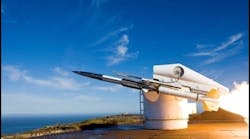By John McHale
SAN DIEGO — Engineers at Space Electronics Inc. (SEI) in San Diego designed a video random-access memory (VRAM) chip to replace eight smaller obsolete VRAM chips in the displays aboard the improved U.S. Army M1A2 Abrams main battle tank.
The VRAM chip is currently on the buyer's list for the tank and will be used when needed, SEI officials say.
The new chip has four times the capacity of the previous eight chips combined, while taking up the same amount of space, says John Parkinson, SEI's digital product manager. SEI is a part of the Maxwell Technologies Electronic Components Group.
The previous VRAM chips that went into the M1A2 tank from General Dynamics Land Systems in Warren, Mich., were designed about 16 to 18 years ago by Microsemi Corp. in Santa Ana, Calif., and went obsolete about five years ago, he adds.
SEI's high-speed, multiport VRAM is designed to meet the military's growing need for replacement parts. SEI's approach to technology insertion involves replacing obsolete integrated circuits with modern, commercial plastic encapsulated modules (PEMs) sealed in hermetic ceramic modules that match the footprint of the components being replaced, SEI officials say.
The 16-bit SEI chip would go into each of the three heads-up displays within the tank that belong to the commander, the driver, and the gunner, Parkinson says. General Dynamics engineers designed all three displays, he adds.
Without the SEI VRAM, General Dynamics designers may have to redesign an entire board costing anywhere from $6 million to $20 million, Parkinson says. The SEI VRAM chip costs about $3,000 while the eight chips it replaces cost a combined $6,400, he explains.
"By encasing a commercial device in a hermetic module, the replacement part has the durability to withstand the rigors of a military mission and thereby functionally replenishes the diminishing supply," Parkinson says. "Because the commercial PEMs are readily available, SEI's solution prevents or significantly deters future obsolescence problems."
The new VRAM supports three types of operation: random access to and from the DRAM, serial access from the serial register, and transfer of data from any row in the DRAM to the serial register.
One VRAM module replaces several different devices of the old system, depending on that system's architecture. The VRAM also features uninterrupted serial-data streams as fast as 45 MHz, 256 serial-register starting locations, three-state serial outputs, and extended data output for fast system cycle times.
The next stop for SEI's VRAM is the U.S. Air Force F-16 fighter aircraft, Parkinson says. SEI officials are currently in negotiations for that contract, he adds.
SEI also provides replacement devices for other forms of RAM, Parkinson says.
For more information on SEI's obsolescence solutions call John Parkinson by phone at 858-503-3343, by mail at 4031 Sorrento Valley Blvd., San Diego, Calif. 92121, or on the World Wide Web at http: www.spacelectronics.com.



